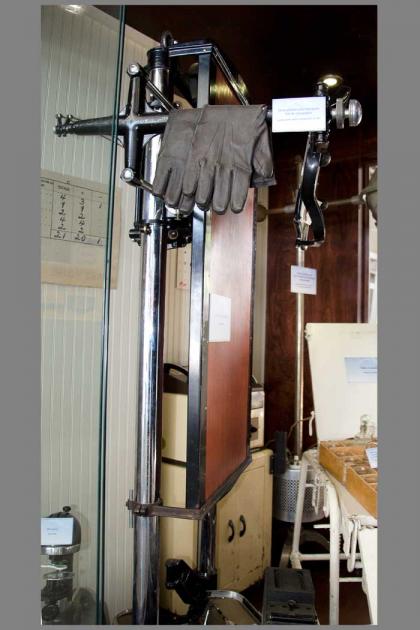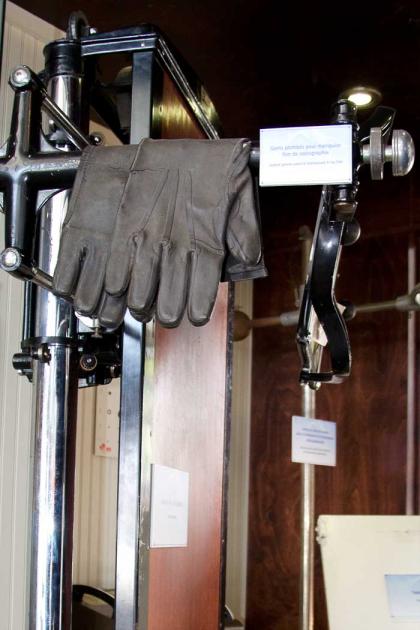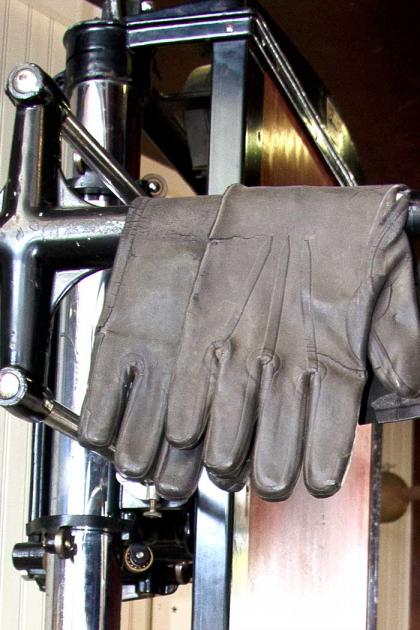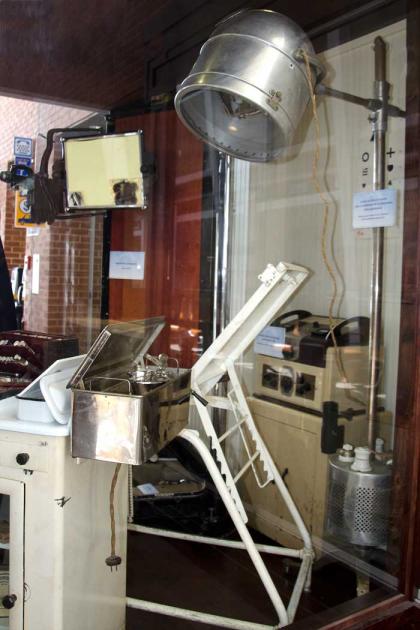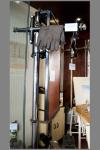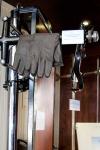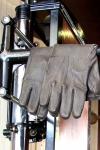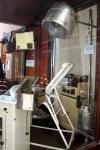X-ray Machine
Organization: CSSS des Sommets
Coordinates: www.csss-sommets.com
Address: 234 St-Vincent, Sainte-Agathe-des-Monts, QC J8C 2B8
Region: Laurentians
Contact: Line Meilleur, line.meilleur.sommets(a)ssss.gouv.qc.ca
Description: Tuberculosis X-ray machine used in the community of Sainte-Agathe des Monts, Quebec
Year made: circa 1934
Made by: Unknown
Materials/Medium: Metal, rubber
Colours: Black, grey and brown
Provenance: Unknown
Size: approx 2 m x 1 m x 50 cm
Photos: Rachel Garber. Courtesy CSSS des Sommets
Tuberculosis X-ray Machine
Joseph Graham
Across the entrance hall from the emergency room at the Sainte Agathe hospital is a display case of early medical equipment, including an old x-ray machine. Most of the pieces relate to a forgotten period of our history when Sainte Agathe was on the front line of the huge battle fought against the greatest enemy mankind has known to date. Tuberculosis killed one billion people between 1700 and 1900, and it struck its victims in the prime of life. Considering that the world population reached two billion only in the 1930s, it is easy to see how devastating this disease was. The threat was so great that students and teachers had an x-ray taken every year, a practice that ended once the disease was treated with antibiotics in the early 1950s.
Lorne McGibbon, the head of the Canada Rubber Company, contracted the disease and was disappointed to learn he would have to go to Saranac Lake, New York, to take the rest cure, the only treatment then available. He determined to correct that. While there, he met a doctor from Sherbrooke, Quebec, who was also taking the cure. He and Dr. J. Roddick Byers became fast friends. Dr. Byers had been delivering as many as four babies a day and finally, exhausted, contracted tuberculosis.
Along with Dr. Hugh M. Kinghorn, who was practicing in Saranac Lake at the time, they talked, rested and shared ideas. McGibbon suggested Sainte Agathe des Monts as an appropriate location for a treatment centre. “Let’s start one, Rod – right now. You go up there and get some land – get lots so we can expand.”
Thanks to its dry climate and its elevation, Sainte Agathe would work perfectly for the rest cure and when Dr. Byers was finally released from hospital, McGibbon sent him off with a cheque in his pocket to purchase a property that was above the village, with spectacular views in all directions. Unfortunately, once Dr. Byers had secured it, he sent a dismayed communication to his friend that Sainte Agathe would not accord them a permit to treat tuberculosis. McGibbon suggested they ask for permission to address the municipal council.
Extolling the virtues of the rest cure, they described the thriving economy of Saranac Lake, no doubt telling them that it was the most important centre of its type in North America and that Dr. Edward L. Trudeau, a descendant of a Quebec family, had established the rest cure there. At the end of a convincing presentation, they offered the councillors a one-week all-expense-paid vacation in Saranac Lake if the council would consider reversing its decision. Of course they did so at a council meeting on November 13, 1908. McGibbon insisted they acquire a boarding house immediately to start caring for patients, and over the next few years they built the Laurentian Sanatorium, opening its doors officially in 1912.
At the same time, Mortimer Davis, founding president of the Imperial Tobacco Company of Canada and president of the Canadian committee of the Jewish Colonization Association, was obliged to repossess a farm in Sainte Agathe from some optimistic young men who had tried to start a commune. They had obtained a loan through the association and could not pay it, abandoning the property one after the other until none remained. It pained Davis to repossess the farm, and during the process, the original house became the responsibility of the Hebrew Benevolent Society and the Baron de Hirsch Institute, which used it for the care of tuberculosis patients. They turned it over to Dr. R. C. Paterson, who began receiving tuberculosis victims at the farmhouse in 1910. Soon Davis and others financed the construction the Mount Sinai Hospital for the treatment of tuberculosis.
Several smaller institutions sprang up in Sainte Agathe and tuberculosis treatment became the largest employer in the Laurentians, surpassing tourism. As importantly, it established an English and Jewish Montreal presence that has persisted to this day.
The x-ray unit on public display once belonged to Dr. Albert Joannette, who practised in Sainte Agathe for 57 years, between 1932 and the end of his life in 1989. He specialized in tuberculosis care and worked in Saranac Lake, New York, as well as in Massachusetts, studied at the Pasteur Institute and worked four years at Les Alpes vaudoises in Switzerland.
Today, the main pavilion of the Laurentian Sanatorium, now the Laurentian Hospital of the CSSS des Sommets, carries the name Pavillon Albert Joannette. It was thanks to his son, Michel Joannette, that the equipment, including the x-ray machine, is displayed at the mini-museum in the main lobby.
Sources
Deadly Diseases, Tuberculosis:
http://www.pbs.org/wgbh/rxforsurvival/series/diseases/tuberculosis.html accessed 2013-01-18.
F. Ryan. Tuberculosis: The Greatest Story Never Told, 1992.
State of World Population, 1930: http://www.antarcticaedu.com/population1930.htm accessed 2013-01-18.
Containing and Preventing Contagious Disease: Montreal’s Protestant School Board and Tuberculosis, 1900-1947, http://www.cbmh.ca/index.php/cbmh/article/view/1237/1228 accessed 2013-01-20.
New Jersey Medical School, Global Tubereculosis Institute, History of TB: http://www.umdnj.edu/ntbcweb/tbhistory.htm accessed 2013-01-20.
Personal scrapbook belonging to the late Barbara McGibbon, undated article from Montreal Star “Early Days at ‘San’ Recalled” by Fred Poland.
Definition of Sanatorium, Webster New International Dictionary, 1913.
Dr. Edmond Grignon, Album Historique de la Paroisse de Sainte Agathe des Monts, 1849-1912.
Joanne Burgess, Dictionary of Canadian Biography, Davis, Sir Mortimer Barnett.
Terrebonne land registry office, deed number 59041, February 8, 1911.
Forty-seventh Annual Report of the Baron de Hirsch Institute and the Hebrew Benevolent Society, for year ending September 30, 1910, Jewish Public Library.
Association pulmonaire, Québec, Fondation Québécoise en santé respiratoire, Témoignage, 7. Le docteur Albert Joannette: http://www.pq.poumon.ca/about-propos/book-livre/temoignage/ accessed 2013-01-20.
To Learn More
www.laurentian.quebecheritageweb.com
G.J. Wherrett, The Miracle of the Empty Beds: A History of Tuberculosis in Canada, 1977.
Author
Joseph Graham is an historian who specializes in examining the world through the lens of Laurentian history. He is the author of the best-selling book Naming the Laurentians, writes a regular column for Main Street, has frequently been published in the Gazette of Montreal and the Quebec Heritage News and authored the feature article of a recent issue of Canada's History Magazine.


